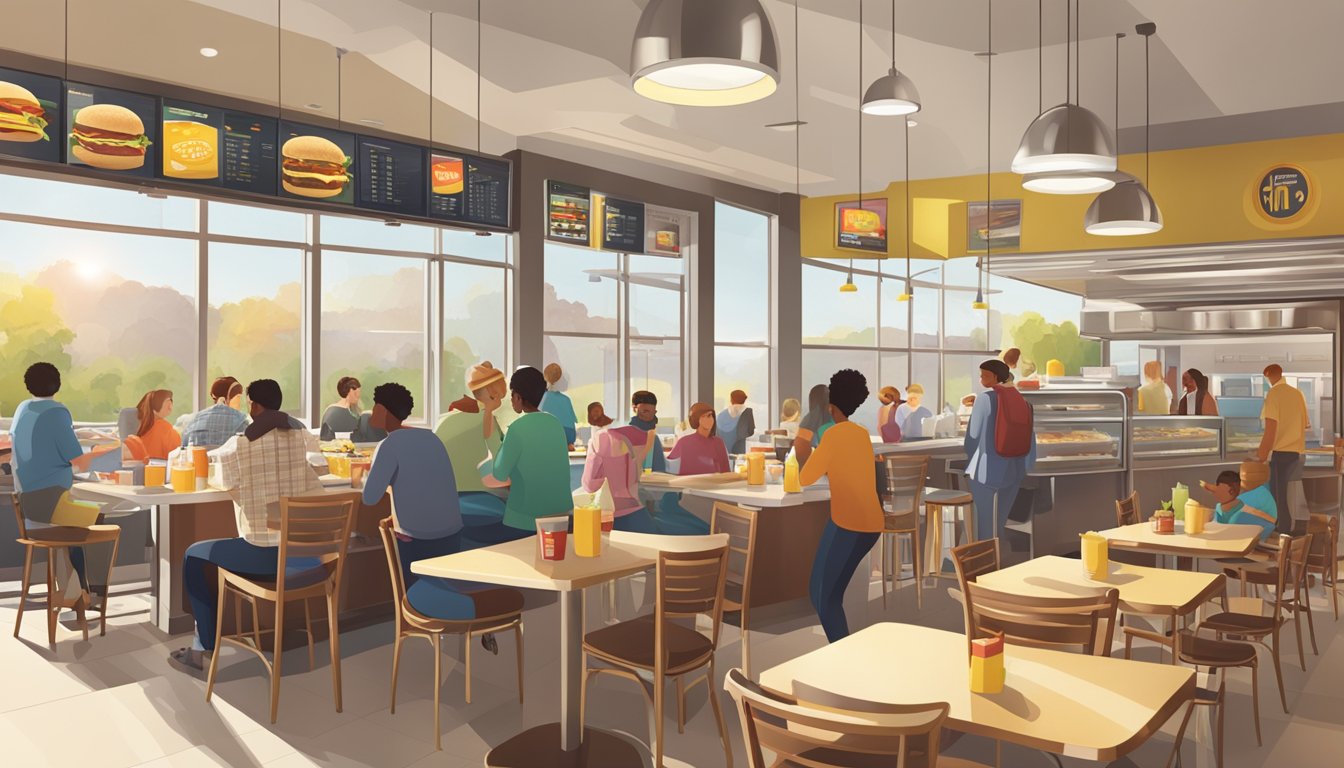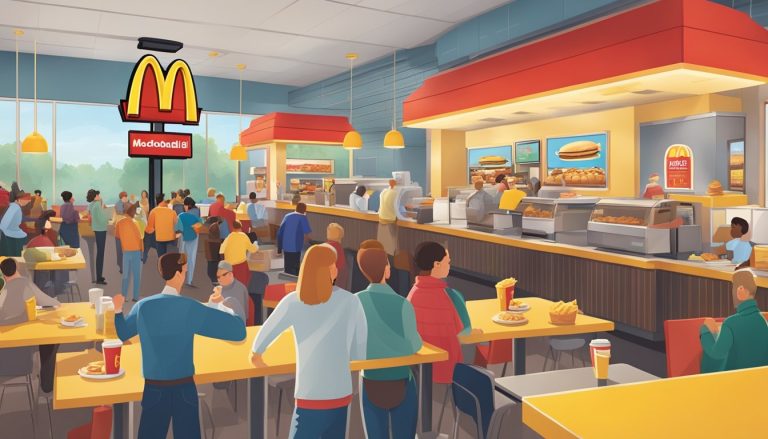McDonald’s decision to offer breakfast items all day long marked a significant shift in the fast-food industry. This move, implemented in October 2015, broke away from traditional mealtime norms and operational constraints that had long restricted breakfast menus to morning hours. The introduction of all-day breakfast at McDonald’s reshaped customer expectations and forced competitors to reconsider their own strategies.
The impact of this change extended beyond just satisfying late-morning cravings for Egg McMuffins. It altered the landscape of fast-food dining, influencing everything from customer behavior to menu development across the industry. The success of this initiative demonstrated the power of listening to consumer demands and adapting business models accordingly.
1) Convenience of Breakfast Anytime
McDonald’s all-day breakfast revolutionized fast food by offering breakfast items at any hour. This move broke traditional mealtime constraints, allowing customers to enjoy their favorite morning foods throughout the day.
The ability to order a McMuffin or hash brown in the afternoon or evening gave customers unprecedented flexibility. It catered to diverse schedules and cravings, accommodating late risers, shift workers, and those with non-traditional routines.
This change also provided more options for families and groups with varied preferences. Parents could order breakfast for children while enjoying lunch items themselves, all in one visit.
The convenience extended to travelers and tourists operating on different time zones. They could satisfy their breakfast cravings regardless of local time, easing the adjustment to new schedules.
McDonald’s all-day breakfast also tapped into the growing trend of breakfast foods as comfort meals. It allowed customers to indulge in these comforting options whenever the mood struck, not just during morning hours.
2) Introduction of the McGriddle

The McGriddle made its grand entrance onto McDonald’s breakfast menu in 2003. This innovative sandwich quickly became a fan favorite, combining sweet and savory flavors in a portable package.
The McGriddle features breakfast staples like eggs, cheese, and meat nestled between two pancake-like griddle cakes. These unique buns are infused with maple syrup, creating pockets of sweetness throughout.
Available in three varieties – Sausage; Sausage, Egg & Cheese; and Bacon, Egg & Cheese – the McGriddle offers options to suit different tastes. Its clever design allows customers to enjoy a complete breakfast in handheld form.
The McGriddle’s popularity has led to strong sales and a dedicated following. Some customers have even petitioned for its availability beyond breakfast hours in certain markets.
As part of McDonald’s breakfast lineup, the McGriddle has contributed to the company’s success in the morning meal segment. It exemplifies McDonald’s ability to innovate and meet changing consumer preferences.
3) Increased Customer Flexibility
McDonald’s all-day breakfast revolutionized customer choice in fast food. Prior to this change, breakfast items were only available during morning hours, limiting options for late risers or those craving breakfast foods later in the day.
The introduction of all-day breakfast allowed customers to enjoy their favorite morning menu items at any time. This flexibility catered to diverse schedules and preferences, accommodating shift workers, students, and anyone with non-traditional eating patterns.
Customers could now satisfy their cravings for Egg McMuffins, hotcakes, or hash browns regardless of the time. This freedom of choice enhanced the overall dining experience and increased customer satisfaction.
The move also addressed the growing trend of consumers seeking breakfast foods beyond traditional morning hours. It tapped into the popularity of “brinner” (breakfast for dinner) and allowed McDonald’s to meet evolving consumer demands.
By removing time constraints on breakfast offerings, McDonald’s demonstrated responsiveness to customer needs. This flexibility became a key differentiator in the competitive fast food landscape, attracting customers who valued the ability to customize their meal choices throughout the day.
4) Bringing Back the Egg McMuffin
The Egg McMuffin holds a special place in McDonald’s breakfast history. Introduced in 1975, it revolutionized the concept of breakfast on the go. This iconic sandwich quickly became a morning favorite for many customers.
All-day breakfast allowed fans to enjoy the Egg McMuffin beyond traditional morning hours. It satisfied cravings for the classic combination of egg, Canadian bacon, and cheese on a toasted English muffin at any time of day.
The availability of the Egg McMuffin throughout the day appealed to shift workers, breakfast enthusiasts, and those seeking a lighter meal option. It provided a familiar and comforting choice for customers regardless of when they visited McDonald’s.
Bringing back the Egg McMuffin as part of all-day breakfast demonstrated McDonald’s responsiveness to customer demand. Many patrons had long requested the ability to order breakfast items outside of morning hours.
The extended availability of the Egg McMuffin also showcased McDonald’s ability to adapt its kitchen operations. It required adjustments to cooking processes and equipment to serve breakfast alongside regular menu items throughout the day.
5) Broader Menu Appeal
McDonald’s all-day breakfast expanded menu options beyond traditional lunch and dinner items. This change allowed customers to satisfy breakfast cravings at any time of day. The increased variety appealed to a wider range of tastes and preferences.
Offering breakfast items alongside regular menu options gave diners more choices. Those seeking lighter fare could opt for breakfast sandwiches or oatmeal instead of burgers. This flexibility catered to health-conscious consumers and those with specific dietary needs.
The expanded menu also attracted new customer segments. People who previously avoided McDonald’s due to limited options found more appealing choices. This included those who preferred breakfast foods or sought more diverse meal selections.
All-day breakfast created opportunities for unique food combinations. Customers could mix breakfast and regular menu items, creating personalized meals. This customization aspect enhanced the dining experience and encouraged experimentation.
The broader menu appeal contributed to increased customer satisfaction. It allowed McDonald’s to better meet varied customer needs throughout the day. This strategy helped the company stay competitive in the fast-food market.
6) Boosted Morning Sales
McDonald’s all-day breakfast initiative unexpectedly led to increased morning sales. Contrary to initial concerns about cannibalizing traditional breakfast hours, the availability of breakfast items throughout the day actually drove more customers to visit during morning hours.
This boost in morning traffic can be attributed to increased awareness and excitement surrounding McDonald’s breakfast offerings. The constant promotion of all-day breakfast reminded customers of the appeal of classic morning menu items.
Additionally, the flexibility of all-day breakfast reduced pressure on customers to arrive before the traditional cut-off time. This resulted in more relaxed morning visits and a steadier flow of customers throughout breakfast hours.
The expanded breakfast menu also attracted new customers who previously didn’t consider McDonald’s for their morning meals. This influx of new patrons contributed significantly to the growth in morning sales.
Data showed that many customers who came for breakfast items later in the day were more likely to return during traditional breakfast hours as well. This created a positive feedback loop, further boosting morning sales.
7) Revolutionized Fast Food
McDonald’s All-Day Breakfast fundamentally changed the fast food landscape. By offering breakfast items throughout the day, the chain broke traditional mealtime boundaries and reshaped customer expectations.
This move challenged other fast food restaurants to reconsider their own menu strategies. Many competitors began extending their breakfast hours or introducing all-day breakfast options to keep pace with McDonald’s innovation.
The shift also impacted food preparation and kitchen operations across the industry. Restaurants had to adapt their equipment and workflows to accommodate simultaneous breakfast and lunch/dinner item production.
All-day breakfast opened up new revenue streams for fast food chains. It allowed them to tap into different customer segments and eating occasions throughout the day, increasing sales potential.
The concept also influenced menu development, leading to the creation of hybrid breakfast-inspired items for lunch and dinner menus. This fusion approach sparked creativity in fast food offerings and appealed to customers seeking variety.
By making breakfast available anytime, McDonald’s set a new standard for convenience and customer choice in the fast food industry. This change reflected a broader trend towards flexible eating schedules and personalized dining experiences.
8) The Breakfast Burrito Surge

McDonald’s introduction of the Breakfast Burrito to its national menu marked a significant expansion of its morning offerings. This Tex-Mex inspired item was created by two Houston-area franchise owners, showcasing the company’s willingness to incorporate regional flavors into its national lineup.
The Breakfast Burrito quickly gained popularity among customers seeking a portable, savory morning option. Its success contributed to the growing demand for all-day breakfast items at McDonald’s.
The burrito’s versatility made it an ideal candidate for the all-day breakfast menu. Its handheld nature appealed to on-the-go customers at any time of day, blurring the lines between traditional breakfast and lunch options.
As all-day breakfast became a reality, the Breakfast Burrito’s availability throughout operating hours further cemented its status as a menu staple. This expansion allowed McDonald’s to tap into the growing market for Mexican-inspired fast food offerings.
The surge in Breakfast Burrito popularity also inspired competitors to develop similar items, leading to an industry-wide increase in breakfast wrap options. This trend continues to influence fast food menus today.
9) Adaptation to Customer Demands
McDonald’s decision to offer all-day breakfast showcased the company’s responsiveness to customer preferences. For years, patrons had expressed a desire for breakfast items beyond traditional morning hours.
The move demonstrated McDonald’s ability to listen and adapt to changing consumer needs. It reflected a shift in eating habits, with many people seeking breakfast foods at various times throughout the day.
This adaptation allowed McDonald’s to cater to diverse schedules and lifestyles. Shift workers, late risers, and those craving breakfast for dinner could now enjoy their favorite morning menu items at any time.
The all-day breakfast initiative also addressed the growing trend of meal customization. Customers gained the flexibility to mix breakfast and regular menu items, creating unique meal combinations.
By meeting this long-standing customer demand, McDonald’s strengthened its competitive position in the fast-food market. The move helped attract new customers and re-engage those who had previously limited their visits to morning hours.
10) Expansion of Business Hours
McDonald’s all-day breakfast offering allowed the fast food chain to effectively extend its operational hours for breakfast items. This move enabled customers to enjoy their favorite morning meals at any time of day.
The expansion of breakfast hours created new revenue opportunities for McDonald’s. By serving popular breakfast items throughout the day, the company could attract customers during traditionally slower periods.
This strategy helped McDonald’s compete more effectively with other restaurants that offered breakfast-style foods all day. It gave McDonald’s an edge in capturing customers who craved breakfast items outside of conventional morning hours.
The extended availability of breakfast foods also provided more options for shift workers, night owls, and others with non-traditional schedules. These customers could now access their preferred breakfast choices regardless of the time they visited McDonald’s.
By broadening the timeframe for breakfast service, McDonald’s increased its flexibility to meet diverse customer needs. This adaptation to changing consumer preferences demonstrated the company’s commitment to customer satisfaction and market responsiveness.
Impact on Breakfast Industry
McDonald’s all-day breakfast initiative reshaped the fast food landscape and consumer expectations around morning meal options. It sparked major changes in how breakfast was served and marketed across the industry.
Increased Competition
Fast food chains scrambled to keep up with McDonald’s expanded breakfast hours. Competitors like Taco Bell, Burger King, and Wendy’s launched or enhanced their own breakfast menus to stay relevant.
Some restaurants extended breakfast hours or introduced all-day options. Others focused on unique items to differentiate themselves. Taco Bell rolled out breakfast burritos, while Wendy’s emphasized fresh-cracked eggs.
Menu innovation accelerated as chains vied for breakfast market share. New sandwiches, bowls, and portable options proliferated. Healthier choices and premium ingredients also gained prominence.
Rise of Flexible Dining
All-day breakfast normalized eating traditional morning foods at any time. This shift blurred the lines between defined mealtimes. Consumers embraced greater flexibility in when and what to eat.
Restaurants adapted by offering more customizable options. Mix-and-match menus became common, allowing patrons to combine breakfast and lunch items. Some chains introduced hybrid “brunch” menus to cater to evolving tastes.
The trend extended beyond fast food. Casual dining and even upscale restaurants began featuring all-day breakfast items. Brunch culture flourished, with weekend breakfast becoming a social occasion at many establishments.
Customer Response and Satisfaction
McDonald’s all-day breakfast launch resonated strongly with consumers, driving positive sentiment and increased sales. The move addressed longstanding customer requests and generated significant buzz on social media platforms.
Meeting Consumer Demand
McDonald’s decision to offer breakfast items all day directly responded to a top customer request. For years, patrons had expressed frustration at being unable to order popular breakfast foods like Egg McMuffins and hash browns after the traditional morning cutoff time.
The expanded menu availability gave customers more choices and flexibility in their dining options. This change particularly appealed to shift workers, late risers, and those craving breakfast foods at non-traditional times.
Sales figures reflected the positive reception. In the first quarter after the nationwide rollout in October 2015, McDonald’s reported a 5.7% increase in same-store sales growth in the U.S. This outperformed the rest of the fast food sandwich segment by 2.9 percentage points.
Positive Social Media Buzz
The all-day breakfast launch generated substantial excitement on social media platforms. Customers took to Twitter, Facebook, and Instagram to express their enthusiasm for the expanded menu options.
Many shared photos of their breakfast orders at unconventional times, often using hashtags like #AllDayBreakfast or #McDonalds. This organic, user-generated content provided valuable free marketing for the company.
The social media buzz helped reinforce McDonald’s image as a brand responsive to customer desires. It also attracted new and lapsed customers curious to try the all-day breakfast offerings, further driving foot traffic and sales.




